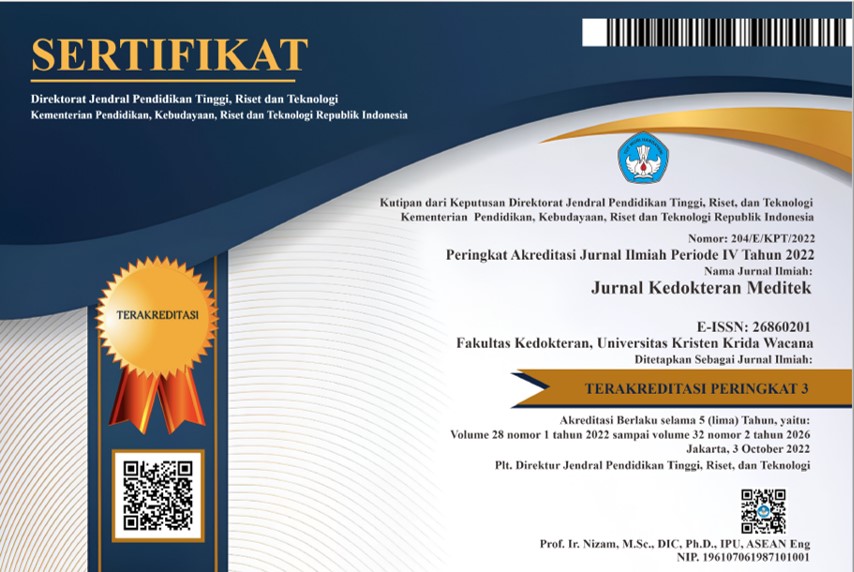Severe Preeclampsia Complicated by Placental Abruption Leads to Fetal Distress
DOI:
https://doi.org/10.36452/jkdoktmeditek.v29i1.2432Keywords:
fetal distress, obstrectic emergency, placental abruption, preeclampsiaAbstract
Placental abruption is a common complication of preeclampsia. It is an obstetric emergency that occurs when the placenta partially or completely separates from the uterine wall. The diagnosis is usually made clinically or objectively. It is relatively rare but put a serious risk for both the fetus and the mother. We reported a case of a 32-year-old multigravid patient at 35-36 weeks gestation who presented with moderate vaginal bleeding and lower abdominal pain. Her obstetric history included one premature vaginal delivery. Her blood pressure started to rise in the second trimester of pregnancy. The examination revealed that her blood pressure was 190/120 mmHg, and she had pitting edema on her extremities and tender uterine fundus. The fetal heart rate was bradycardia at 100 beats per minute. Placental abruption and fetal distress were suspected. An emergency cesarean section was performed. Intraoperatively, the uterus showed intramural bleeding and was livid, with the beginning of Couvelaire-uterus. The uterus was left in situ. In conclusion, placental abruption interrupts the vital function of the placentae which leads to fetal hypoxia and even fetal death. It is an obstetric emergency that requires immediate intervention to save the fetus and reduce the risk of complications in the mother.
References
Schmidt P, Skelly CL, Raines DA. Placental abruption. In: StatPearls [Internet]. [dikutip 10 November 2021]. Diunduh dari https://www.ncbi.nlm.nih.gov/books/NBK482335/
Parker SE, Werler MM, Gissler M, Tikkanen M, Ananth CV. Placental abruption and subsequent risk of pre-eclampsia: a population-based case-control study. Paediatr Perinat Epidemiol. 2015;29(3):211-9.
Sylvester HC, Stringer M. Placental abruption leading to hysterectomy. BMJ Case Report. 2017;2017:bcr2016218349.
Tewari V, Dharmavijaya MN, Deepika N. Incidence of abruptio placentae in preeclampsia in a rural tertiary care hospital. International Journal of Clinical Obstetrics and Gynaecology 2020;4(6):135-8.
Hypertension in pregnancy. Report of the American college of obstetricians and gynecologists’ task force on hypertension in pregnancy. Obstet Gynecol. 2013;122(5):1122-31.
Shoopala HM, Hall DR. Re-evaluation of abruptio placentae and other maternal complications during expectant management of early onset pre-eclampsia. Pregnancy Hypertension. 2019;16:38-4.
Sass N, Nagahama G, Korkes HA. Placental abruption in each phenotype of hypertensive disorders of pregnancy: a retrospective cohort study using a national inpatient database in Japan. Hypertens Res. 2021;44(2):250-2.
Tikkanen M. Etiology, clinical manifestations, and prediction of placental abruption. Acta Obstet Gynecol Scand. 2010;89(6):732-40.
Ananth CV, Keyes KM, Hamilton A, Gissler M, Wu C, Liu S, et al. An international contrast of rates of placental abruption: an age-period-cohort analysis. PLoS One. 2015;27;10(5):e0125246.
Uwagbai ON, Wittich AC. A 30-year-old female found to have a couvelaire uterus with placenta accreta during planned cesarean delivery. Mil Med. 2017;182(3):e1877-9.
Mikuscheva A, Strassding F, MacKenzie E. Three cases of severe placental abruption as a first symptom of preeclampsia. Case Reports in Obstetrics and Gynecology, 2021.
Sánchez-Aranguren LC, Prada CE, Riaño-Medina CE, Lopez M. Endothelial dysfunction and preeclampsia: role of oxidative stress. Front Physiol. 2014;5:372.
Li Y, Tian Y, Liu N, Chen Y, Wu F. Analysis of 62 placental abruption cases: risk factors and clinical outcomes. Taiwan J Obstet Gynecol. 2019;58(2):223-226.
Singgih R, Sinaga RJ, Sinaga YH. Uterus couvelaire after caesarean section: a challenging case report. Majalah Obstetri Dan Ginekologi. 2021;29(2):68–71.
Rathi M, Rathi SK, Purohit M, Pathak A. Couvelaire uterus. BMJ Case Rep. 2014;2014:bcr2014204211.
Editors. Cunningham F, & Leveno KJ, & Dashe JS, & Hoffman B., & Spong CY, & Casey BM.(Eds.), (2022). Williams Obstetrics, 26e. McGraw Hill
Downloads
Published
How to Cite
Issue
Section
License
Copyright (c) 2023 Aloysius Suryawan, Indra Hapdijaya, Ecclesia Tessalina, Elisabeth Mariska Natasha Herdiana, Janice Natalia, Gede Anggara Setya Dewa Brata, Hendrik Andrianto, Catharine Welanai Jemarut, Livia Devina

This work is licensed under a Creative Commons Attribution-NonCommercial-ShareAlike 4.0 International License.

















